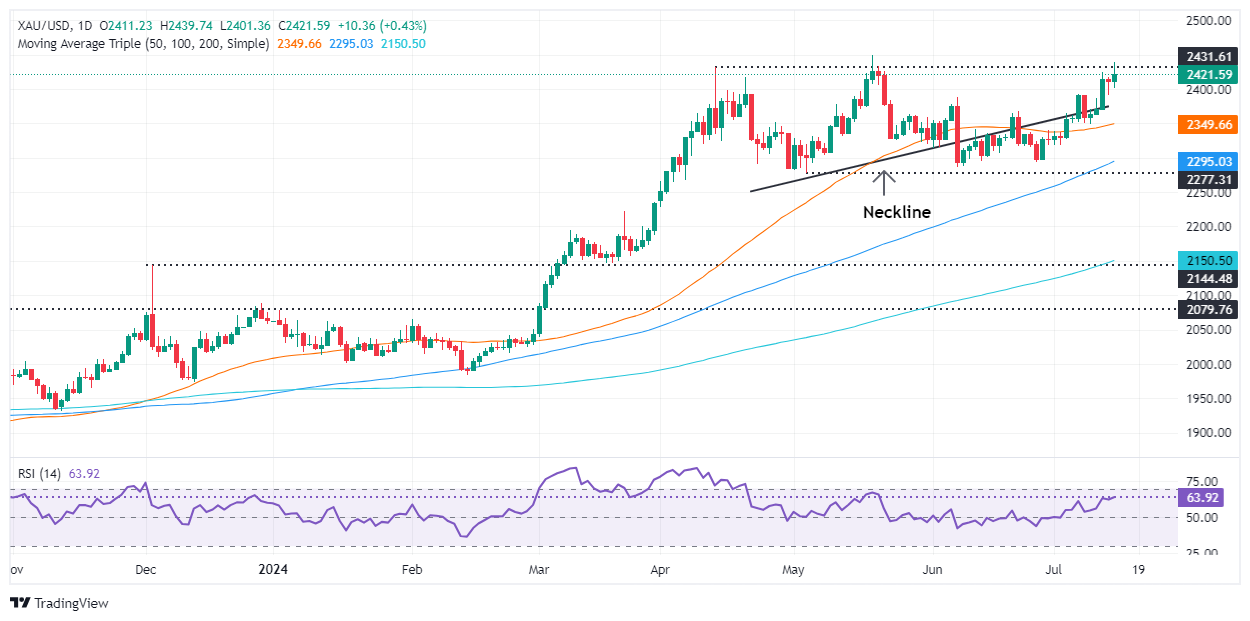Gold price rises as Fed rate cut hopes grow

- Gold extends gains for a third week, rising 0.51% to $2,422.
- Fed Chair Powell’s cautious comments on inflation and rate cuts subtly influence market sentiment.
- US Treasury yields increase, with the 10-year note up four basis points to 4.227%, amid expectations for a September rate cut.
Gold price advanced on Monday after achieving three weeks of consecutive gains, yet exchanges hands off daily high after the Federal Reserve Chairman Jerome Powell stuck to its rhetoric, failing to provide forward guidance. The XAU/USD trades at $2,422, up by 0.51%.
The yellow metal opened Monday’s session slightly lower following Trump’s assassination attack over the weekend, which bolstered his chances of winning November’s election. This boosted the Greenback, though worries faded, and the XAU/USD resumed its bullish trend, lifting Gold prices towards a multi-week high of $2,439.
In the meantime, Fed Chair Jerome Powell’s appearance at The Economic Club of Economic Club was uneventful. He said the economy has performed “remarkably well” and added the labor market isn’t as tight as in the pandemic.
Powell added that the Fed will not wait until inflation reaches 2% to cut rates, though policymakers want to be confident that inflation is moving down.
Following Powell’s remarks, US Treasury bond yields edged higher in the belly and the long end of the curve. The US 10-year Treasury note is up four basis points (bps) at 4.227%.
According to the CME FedWatch Tool, traders are pricing a 98% chance that the Fed might cut rates a quarter of a percentage point in September.
Daily digest market movers: Gold price consolidates above $2,400
- Weaker than expected US Consumer Price Index (CPI) data, sponsored Gold’s leg-up above $2,400 as odds for Fed rate cuts increase as reflected by falling US Treasury bond yields.
- The US economic docket will feature Retail Sales, housing data, Initial Jobless Claims, and further Federal Reserve speakers.
- Meanwhile, the US Dollar Index (DXY), which tracks the Greenback against a basket of six currencies, is up more than 0.13% to 104.21.
- December 2024 fed funds rate futures contract implies that the Fed will ease policy by 53 basis points (bps) toward the end of the year, up from 50 last Friday.
- Bullion prices retreated slightly due to the People’s Bank of China (PBoC) decision to halt gold purchases in June, as it did in May. By the end of June, China held 72.80 million troy ounces of the precious metal.
Technical analysis: Gold price remains bullish, despite buyers taking a respite
Gold price remains above $2,400, posting gains of a half-percent yet failing to remain near daily highs of $2,439. Momentum remains bullish, but near-term hints that buyers are taking a breather, as depicted by the Relative Strength Index (RSI) standing flat but bullish.
If XAU/USD edges above $2,439, that would pave the way to test the year-to-date (YTD) high of $2,450. Further gains are seen once cleared, with the $2,500 figure up next. Otherwise, if XAU/USD slumps below $2,400, the next floor will be the July 5 high at $2,392. If cleared, XAU/USD would continue to $2,350.
Fed FAQs
Monetary policy in the US is shaped by the Federal Reserve (Fed). The Fed has two mandates: to achieve price stability and foster full employment. Its primary tool to achieve these goals is by adjusting interest rates. When prices are rising too quickly and inflation is above the Fed’s 2% target, it raises interest rates, increasing borrowing costs throughout the economy. This results in a stronger US Dollar (USD) as it makes the US a more attractive place for international investors to park their money. When inflation falls below 2% or the Unemployment Rate is too high, the Fed may lower interest rates to encourage borrowing, which weighs on the Greenback.
The Federal Reserve (Fed) holds eight policy meetings a year, where the Federal Open Market Committee (FOMC) assesses economic conditions and makes monetary policy decisions. The FOMC is attended by twelve Fed officials – the seven members of the Board of Governors, the president of the Federal Reserve Bank of New York, and four of the remaining eleven regional Reserve Bank presidents, who serve one-year terms on a rotating basis.
In extreme situations, the Federal Reserve may resort to a policy named Quantitative Easing (QE). QE is the process by which the Fed substantially increases the flow of credit in a stuck financial system. It is a non-standard policy measure used during crises or when inflation is extremely low. It was the Fed’s weapon of choice during the Great Financial Crisis in 2008. It involves the Fed printing more Dollars and using them to buy high grade bonds from financial institutions. QE usually weakens the US Dollar.
Quantitative tightening (QT) is the reverse process of QE, whereby the Federal Reserve stops buying bonds from financial institutions and does not reinvest the principal from the bonds it holds maturing, to purchase new bonds. It is usually positive for the value of the US Dollar.
